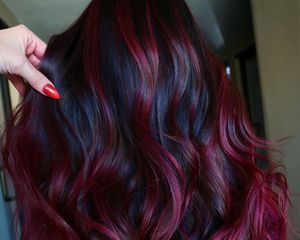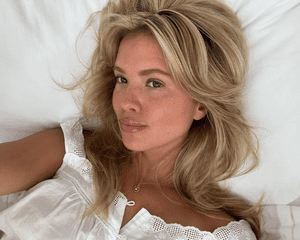
Stocksy
Don’t get us wrong, we love a great hair transformation just as much as anyone else. But sometimes, with a drastic change comes some unexpected hiccups, especially when there's bleach involved. Whether you're looking to add some highlights to already lightened hair, or you're making a total 180 from brunette to blonde, the process can be lengthy and (sometimes) damage-inducing. Luckily, though, most hair changes are rarely permanent and there are lots of solutions for getting your hair healthy again, even after a mishap.
My own quest for a dramatic hair transformation did not go quite as planned. In fact, it involved me disbelievingly watching my just-bleached strands quite literally fall from my burning scalp. Yes, the aftermath of what my friends and I refer to as “the bleach apocalypse" may have been a traumatizing mess, but thanks to a trusted arsenal of products, rituals, talented hair stylists—and, yes, a few healthy trims—my locks are back in tip-top shape. We reached out to the experts for their tips on how to regain healthy hair after it's been wrecked by bleach.
Meet the Expert
- Chase Kusero is the co-founder of hair care line IGK Hair Care.
- Nikki Lee is a hairstylist and the founder of Nine Zero One Salon and In Common Beauty.
Keep reading for 11 helpful steps to take when you suffer a bleached hair disaster.
Seek An Expert's Help
If you've suffered a salon (or self-induced) bleached disaster, the first step is not to panic (as much as you can at least)—then seek another professional's help. Adding more product to your hair, or trying to remedy the disaster yourself, could prove more problematic. "I would recommend calling a professional ASAP," says hairstylist Nikki Lee. "This can be such a fragile and scary process that no one but a professional should touch," she adds. "They will be able to take a look at your hair and come up with a game plan to get it back to health." They've seen it all and are used to treating clients for color corrections.
Don't Try a Quick Fix
When hair is freshly damaged, Lee says to keep your hands off of it in the immediate aftermath. The last thing you want to do is make things worse. By leaving hair in the state it's in, your colorist will be able to go from there rather than having to backtrack and factor in the number of other things you did in an effort to fix it yourself. "Don’t touch it again," she says. "And stay away from YouTube tutorials! Do some proper research to get in with the right colorist in your area to help you achieve your hair color goals without compromising your hair texture or length."
Be Patient
It's super important to allow time for your hair to recover. Again, easier said than done. But, time is the only real cure for allowing hair to heal. (It can take anywhere from a few months to a year to see the return of your healthy hair.) Patience also goes a long way during the blonding process as well. If you're in a rush to lighten your hair, that's often when disaster strikes.
My personal over-bleaching nightmare occurred when I expressed disappointment after a highlight appointment. Wanting to go blonder, the stylist assured me that she could bleach my hair over the highlights and my hair would be blonder — and still healthy. She was wrong. As soon as she began brushing out my newly-bleached strands, they began to fall out. Worried, she suggested I go home and wait for it to dry before any more brushing. As I drove home, out of the corner of my eye, I could see my hair falling and breaking at an alarmingly fast rate. Crying and struggling, I had no clue where to start. Ultimately, I made an appointment at another nearby salon for the next day. The comforting angel of a receptionist was extremely reassuring, telling me there were a number of things the staff could do to try to salvage my hair. So, ever-so-carefully pulling my tangled hair into a scrunchie, I went to sleep hoping for a miracle.
When I arrived at the salon the next day, the owner and about 10 other stylists surrounded me and my matted, bleached hair. The owner’s concerned and frustrated expression didn’t do much to soothe my once-again rising panic, and after studying my hair for awhile, he told me my hair would take a long, long time to recover. It would need the right balance of protein and moisture, along with frequent trims and cuts to try to balance the breakage.
Lay Off the Heat
"We're always seeing clients that have concerns around hair damage, from everyday heat styling, to heavy-duty bleaching and highlighting," says IGK co-founder Chase Kusero. It's best to avoid heat altogether including blow-dryers, hot tools, and even super-hot showers, until your hair is healthier. If you must style your hair, try heat-free alternatives, like loose braids for waves and heatless curlers.
Use an At-Home Repair Kit
Lee suggests looking for products that repairs broken bonds, protects the hair cuticle and replenishes hair with moisture. Those will be effective "on hair suffering extreme damage due to chemical processes, coloring + bleaching services, or on weak, brittle hair." When choosing an at-home treatment, look for keywords like nourishing, strengthening, and reparative. "Follow this with consistent hair trims to get your hair back to health," she adds.
Use a Gentle Shampoo
The name of the game is going to be gentle until your hair is back to its pre-damaged condition. Hair is already at its weakest and most vulnerable state when it's wet, so it's super important to use the right shampoo. Anything clarifying or stripping will just make matters worse, so look for something that's going to hydrate and heal your compromised strands.
Take Your Vitamins
Of course, nutrition is a major component of having healthy hair, but Lee stresses that vitamins on the exterior of the hair (i.e. those that can be applied topically) can do a world of good. Using nourishing shampoos, conditioners and hair treatments packed with vitamins and antioxidants is a great way to topically treat bleach and damaged hair. Ensuring you have adequate intake of your daily vitamins and minerals (whether from a balanced diet or supplementation) is important in restoring hair health, too.
Treat With a Serum
Hair serums act as a protective shield for the hair and are a must-add to your arsenal when dealing with damage from bleaching. Find a hair serum that targets hair repair — with strengthening, nourishing and reparative properties. Even better — use a complete system (shampoo, conditioner and serum) that's designed to work together for ingredient continuity.
Try a Hair Mask and an Oil
Once the bleach is out, and your hair is on the road to recovery, try to hydrate it as best you can. Kusero recommends treating hair with a weekly mask, taking a break from hot tools, and to try going as long as you can between washes to allow natural oils to coat the hair. If you find that your hair is still dry and brittle, add a topical oil as well. Using one before bed or ahead of a workout– especially on your ends– will let the nutrients penetrate your hair for the best results.
Treat With Protein
For me, an intensive protein treatment was key. Its purpose was to help stop the breakage and prevent more from happening. (FYI: Most salons have a multitude of hair treatments that range in strength and purpose. I still alternate between moisture- and protein-packed treatments every couple of months to help maintain my hair’s integrity. I recommend this for anyone who frequently styles with heat or gets regular color).
There are also plenty of protein treatments available for at-home use. While they may not be the same salon-grade formula that your hairstylist can use on you, they can be helpful in between salon visits when you're looking to improve your hair health.
After I received my first post-bleach treatment, the stylist slowly began to comb through my hair. I closed my eyes, but the fistfuls of hair I saw when I opened them still make me cringe. Then came the cut. I got about three or four inches taken off, leaving me with an extremely thinned-out shoulder-length style—a far cry from the razor job I had been dreadfully anticipating, but still an uncomfortable change. After lending some advice as far as products and styling, the salon’s staff had done all they could do and advised me to return within the next month for another consultation, treatment, and trim.
Keep Using Healthy Hair Products, Even Post-Damage
"Damaged hair is more fragile and vulnerable to dryness, brittleness and breakage," Kusero says. "It responds best to formulas that are nourishing, strengthening, repairing, and extra gentle."
After visiting numerous other salons and doing hours and hours of research on the internet, I came up with a regimen that would ultimately get my hair back into shape. Through trial and error, I found a shampoo and conditioner pairing, plus a hair mask that worked for my unique needs, and I stuck with it. Since I didn't touch a blow dryer or flatiron for six months, I also relied on a light leave-in product to deliver shine, manageability, and natural body to my hair.












